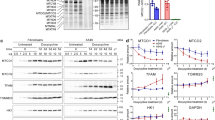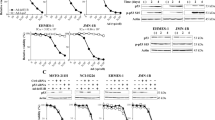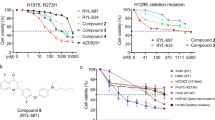Abstract
Treating lung cancer cell lines using low-dose 5-aza-2′-deoxycytidine (DAC) caused an accumulation of procaspase-9 through mRNA upregulation, but the cells did not undergo apoptosis. However, when cells were treated with DAC and infected with a low dose of a recombinant wild-type p53 adenovirus vector (Ad-p53), a synergistic growth inhibitory effect was observed. Combination treatment induced Apaf-1 and procaspase-9 expression in which cytochrome c releases by Ad-p53 triggered the mitochondrial pathway of apoptosis. Selective blockage of caspase-9 activities by Z-LEHD-FMK completely attenuated DAC-induced enhancement of apoptosis mediated by Ad-p53 infection, and ectopic overexpression of procaspase-9 sensitized cells to Ad-p53-induced apoptosis in p53-null cells. In addition, DAC sensitized lung cancer cells to cisplatin and paclitaxel. Induction of the mitochondrial pathway of apoptosis using a slightly toxic dose of DAC may therefore be a strategy for treating lung cancer, and DAC treatment may have clinical implications when combined with chemotherapy or apoptosis-inducing gene therapy.
This is a preview of subscription content, access via your institution
Access options
Subscribe to this journal
Receive 50 print issues and online access
$259.00 per year
only $5.18 per issue
Buy this article
- Purchase on Springer Link
- Instant access to full article PDF
Prices may be subject to local taxes which are calculated during checkout






Similar content being viewed by others
References
Ammanamanchi S, Kim SJ, Sun LZ and Brattain MG . (1998). J. Biol. Chem., 273, 16527–16534.
Ammanamanchi S and Brattain MG . (2001). J. Biol. Chem., 276, 32854–32859.
Bender CM, Pao MM and Jones PA . (1998). Cancer Res., 58, 95–101.
Charache S, Dover G, Smith K, Talbot Jr CC, Moyer M and Boyer S . (1983). Proc. Natl. Acad. Sci. USA, 80, 4842–4846.
Debatin KM . (2000). Toxicol. Lett., 112–113, 41–48.
Doerfler W . (1983). Annu. Rev. Biochem., 52, 93–124.
Fulda S, Kufer MU, Meyer E, Valen F, Dockhorn-Dworniczak B and Debatin KM . (2001). Oncogene, 20, 5865–5877.
Herman JG, Merlo A, Mao L, Lapidus RG, Issa JP, Davidson NE, Sidransky D and Baylin SB . (1995). Cancer Res., 55, 4525–4530.
Jackson-Grusby L, Beard C, Possemoto R, Tudor M, Fambrough D, Csankovszki G, Dausman J, Lee P, Wilson C, Lander E and Jaenisch R . (2001). Nat. Genet., 27, 31–39.
Johnstone RW, Ruefli AA and Lowe SW . (2002). Cell, 108, 153–164.
Jones PA and Laird PW . (1999). Nat. Genet., 21, 163–167.
Jones PA . (1996). Cancer Res., 56, 2463–2467.
Jordan P and Carmo-Fonseca M . (2000). Cell Mol. Life Sci., 57, 1229–1235.
Kano Y, Akutsu M, Tsunoda S, Mori K, Suzuki K and Adachi KI . (1998). Cancer Chemother. Pharmacol., 42, 91–98.
Karpf AR, Moore BE, Ririe TO and Jones DA . (2001). Mol. Pharmacol., 59, 751–757.
Kataoka M, Wiehle S, Spitz F, Schumacher G, Roth JA and Cristiano RJ . (2000). Oncogene, 19, 1589–1595.
Kuida K, Haydar TF, Kuan CY, Gu Y, Taya C, Karasuyama H, Su MS, Rakic P and Flavell RA . (1998). Cell, 94, 325–337.
Lapidus RG, Ferguson AT, Ottaviano YL, Parl FF, Smith HS, Weitzman SA, Baylin SB, Issa JJ and Davidson NE . (1996). Clin. Cancer Res., 2, 805–810.
Lee WH, Morton RA, Epstein JI, Brooks JD, Campbell PA, Bova GS, Hsieh WS, Isaacs WB and Nelson WG . (1994). Proc. Natl. Acad. Sci. USA, 91, 11733–11737.
Lenzi R, Raber MN, Gravel D, Frost P and Abbruzzese JL . (1995). Int. J. Oncol., 6, 447–450.
Mihara M, Erster S, Zaika A, Petrenko O, Chittenden T, Pancoska P and Moll UT . (2003). Mol. Cell, 11, 577–590.
Moroni MC, Hickman ES, Denchi EL, Caprara G, Colli E, Cecconi F, Muller H and Helin K . (2001). Nat. Cell Biol., 3, 552–558.
Myeroff LL, Parsons R, Kim SJ, Hedrick L, Cho KR, Orth K, Mathis M, Kinzler KW, Lutterbaugh J and Park K . (1995). Cancer Res., 55, 5545–5547.
Nishiyama J, Yi X, Venkatachalam MA and Dong Z . (2001). Biochem. J., 360, 49–56.
Nishizaki M, Meyn RE, Levy LB, Atkinson EN, White RA, Roth JA and Ji L . (2001). Clin. Cancer Res., 7, 2887–2897.
Ohtani-Fujita N, Fujita T, Aoike A, Osifchin NE, Robbins PD and Sakai T . (1993). Oncogene, 8, 1063–1067.
Pinto A, Attadia V, Fusco A, Ferrara F, Spada OA and Di Fiore PP . (1984). Blood, 64, 922–929.
Soengas MS, Capodieci P, Polsky D, Mora J, Esteller M, Opitz-Araya X, McCombie R, Herman JG, Gerald WL, Lazebnik YA, Cordon-Cardo C and Lowe SW . (2001). Nature, 409, 207–211.
Steel GG and Peckham MJ . (1979). Int. J. Radiat. Oncol. Biol. Phys., 5, 85–91.
Wang TH, Wang HS and Soong YK . (2000). Cancer, 88, 2619–2627.
Wu GS and Ding Z . (2002). Oncogene, 21, 1–8.
Yoshida H, Kongr YY, Yoshida R, Elia AJ, Hakem A, Hakem R Penninger JM and Mak TW . (1998). Cell, 94, 325–337.
Yoshiura K, Kanai Y, Ochiai A, Shimoyama Y, Sugimura T and Hirohashi S . (1995). Proc. Natl. Acad. Sci. USA, 92, 7416–7419.
Zhang WW, Fang X, Branch CD, Mazur W, French BA and Roth JA . (1993). Biotechniques, 15, 868–872.
Zou H, Henzel WJ, Liu X, Lutschg A and Wang X . (1997). Cell, 90, 405–413.
Acknowledgements
We thank Dr Masahiko Nishizaki for technical advice, and Carmelita Concepcion and Peggy James for the preparation of this manuscript. This work was partially supported by a grant from the National Cancer Institute, National Institutes of Health (PO1 CA78778-01A1; to JAR), the SPORE grant (2P50-CA70970-04), a developmental grant from the National Cancer Institute to MD Anderson Cancer Center SPORE in lung cancer; P50-CA70907 to TM, the Cancer Center Support Core Grant CA 16672 to the Division of Surgery at MD Anderson, a grant from the Tobacco Settlement Funds as appropriated by the Texas Legislature (Project 8), the WM Keck Foundation, and a sponsored research agreement with Introgen Therapeutics, Inc. (SR93-004-1).
Author information
Authors and Affiliations
Corresponding author
Rights and permissions
About this article
Cite this article
Gomyo, Y., Sasaki, Ji., Branch, C. et al. 5-aza-2′-deoxycytidine upregulates caspase-9 expression cooperating with p53-induced apoptosis in human lung cancer cells. Oncogene 23, 6779–6787 (2004). https://doi.org/10.1038/sj.onc.1207381
Received:
Revised:
Accepted:
Published:
Issue Date:
DOI: https://doi.org/10.1038/sj.onc.1207381
Keywords
This article is cited by
-
The Methylation Inhibitor 5-Aza-2′-Deoxycytidine Induces Genome-Wide Hypomethylation in Rice
Rice (2022)
-
3D cell cultures, as a surrogate for animal models, enhance the diagnostic value of preclinical in vitro investigations by adding information on the tumour microenvironment: a comparative study of new dual-mode HDAC inhibitors
Investigational New Drugs (2022)
-
Decitabine augments cytotoxicity of cisplatin and doxorubicin to bladder cancer cells by activating hippo pathway through RASSF1A
Molecular and Cellular Biochemistry (2018)
-
Gene expression profiling of the synergy of 5-aza-2′-deoxycytidine and paclitaxel against renal cell carcinoma
World Journal of Surgical Oncology (2012)
-
Synergetic effects of DNA demethylation and histone deacetylase inhibition in primary rat hepatocytes
Investigational New Drugs (2012)



